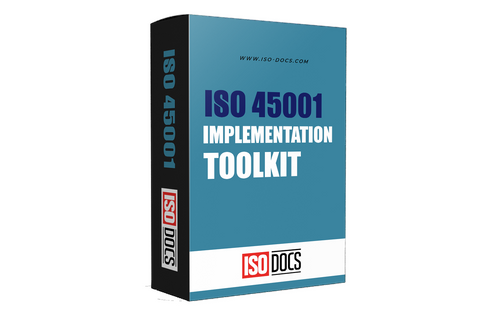ISO 45001 Compliance Register Template
Introduction
A compliance register ISO 45001 (commonly referred to as a legal register) is a cornerstone resource used by organizations who are interested in ensuring that their activities remain in line with current health and safety standards and practices. It is a documented and frequently revised register of all legal, regulatory and other compliance requirements pertaining to occupational health and safety (OHS).

Important Characteristics And Functions ISO 45001 Compliance Register
-
Comprehensive Listing: The register must also contain local, regional, national and international regulations and laws on OHS, standards, permits, licenses and industry codes, and contractual provisions that have a bearing on the operations of organizations.
-
Jurisdiction Details: Designate the geographical area of each of the listed regulations to enable organizations to differentiate the requirements that need to be adhered to at various locations or business unit.
-
Status of Compliance: Identify whether the organization is compliant with each requirement or not with any known outstanding actions, deadlines, and non-compliance or risks.
-
Responsible Parties: Per person or group: Allocate people or teams to be in charge of compliance to every requirement, hold to account and follow up.
- Policy/Procedure References: Provide links to related organizational procedures, policies and evidence records that reflect a demonstrated way of compliance.
Purpose And Importance ISO 45001 Compliance Register
- Awareness of Regulations: The compliance register ensures that the legal requirements are not ignored and the chances of non-compliance are reduced.
-
Continuous Improvement: Through monitoring of the changing regulations and compliance status, organizations are able to manage their risks proactively, update controls and enhance their safety management system.
-
Audit and Review: It simplifies internal and external audit processes whereby auditors and managers can easily check the compliance status and evidence.
- Integration with OH&S Management System: The register should be used to support the risk management, incident investigation, internal audit and corrective measures to maintain sustained compliance when integrated with the broader OHS management system.

Compliance Register Integration With OHS Management System
To carry out maximum value, the compliance register has to be completely integrated in your broader OHSMS procedures:
-
Risk Management: The register should be used in risk identification and assessment to make sure that all hazards are taken into account in the light of legal requirements and compliance obligations.
-
Incident Management: Map incident investigations with pertinent requirements of regulatory requirements on accurate reporting and corrective action planning.
- Audits and Reviews: We recommend using the register as a checklist with audits and workplace reviews to make sure that every field of compliance is effectively followed.
Integration has the effect of enhancing compliance performance and removing discrepancies between the intent of regulation and actual operation.
Difficulties In The Implementation Of Compliance Register.
1. Complexity in Multinational Operations: Dissimilar local and regional, national, and international regulations require painstaking mapping and tracing.
2. Regulatory Change: The changing laws or amendments need to be agile, and systematically introduced and become aware of these changes.
3. Ownership: Requirements will stagnate, risks increase without a clear allocation.
4. Accessibility and Usability: Registers should be read and searchable and actable- not an administrative drain burdened with obsolete or concealed records.
5. Audit Alignment: Registers are seen as compliance checklists, not dynamic management tools unless they are put in place as part of audit processes.
The best way to overcome these challenges in organizations is through effective leadership, committed compliance management positions, frequent reviews, and document control systems that are technology-supported.
Updating And Keeping The Compliance Register
There is no such thing as a compliance register that is stagnant. Organizations are required to maintain it constantly updated in order to be in compliance with ISO 45001:
-
Constant Checks: Be aware of the developments by subscribing to regulatory news, government newsletters, and news in the industry.
-
Routine Audits: Complete a routine check of the register, which is compared with new regulations, incidents or findings of the audit.
-
Training: Train the compliance stakeholders about the updates and changes on a regular basis.
- Records Revisions: Modify the entries in good time and with new responsibilities, new status, or additions.
To ensure the ongoing maintenance of a healthy legal and safety environment, a well-maintained register is more of a real-time dashboard both to support everyday management and to facilitate the external audit scrutiny.
Strategic Benefits Of A Strong Compliance Register
1. Risk Reduction- A detailed compliance register will help reduce fines, lawsuits, and reputation loss and help quickly rectify in case of a case.
2. OHSAS Occupational Health and Safety Assessment Series- Understanding and monitoring all the needs enhances the adoption of proper safety measures, which safeguard employees and minimize accident incidence.
3. Ready to Audit and Certify- The current registers, which are linked with documented evidence facilitate external and internal audits, and bridging any gaps and being able to show systematic management to certifiers.
4. Business Continuity and Reputation- Some of the most common threats to business continuity and trust within the organization include legal crises or compliance failures. The register is a proactive and reputation protective tool.
5. Performance monitoring and Improvement- Registers enable the analysis of the performance of compliance through the course of time, trends, systemic problems, and learning opportunities within the organization.
Conclusion
The ISO 45001 compliance register is the pulse of successful health and safety management- it transforms the legal requirements and regulations of the intricate world into simple actions and duties. It is also its strength since it is up to date, practical, and is so deeply embedded in the organizational processes, such as in risk management and audits, or training and incident examination.


